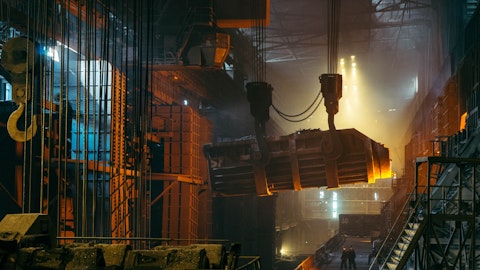TimkenSteel Corporation (NYSE:TMST) Q3 2023 Earnings Call Transcript November 3, 2023
Operator: Good morning, and welcome to TimkenSteel’s Third Quarter 2023 Conference Call. All participants are in a listen-only mode. After the speakers’ presentation, we will conduct a question-and-answer session. As a reminder, this conference call is being recorded. I would now like to turn the call over to Jennifer Beeman, Director of Communications and Investor Relations. Thank you. Please go ahead.
Jennifer Beeman: Good morning, and welcome to TimkenSteel’s third quarter 2023 conference call. I’m Jennifer Beeman, Director of Communications and Investor Relations for TimkenSteel. Joining me today is Mike Williams, President and Chief Executive Officer; Kris Westbrooks, Executive Vice President and Chief Financial Officer; and Kevin Raketich, Executive Vice President and Chief Commercial Officer. You all should have received a copy of our press release, which was issued last night. During today’s conference call, we may make forward-looking statements as defined by the SEC. Our actual results may differ materially from those projected or implied due to a variety of factors, which we describe in greater detail in yesterday’s release.
Please refer to our SEC filings including our most recent Form 10-K and Form 10-Q and the list of factors included in our earnings release, all of which are available on the TimkenSteel website. Where non-GAAP financial information is referenced, additional details and reconciliations to its GAAP equivalent are also included in the earnings release. With that, I’d like to turn the call over to Mike. Mike?
Mike Williams: Good morning, everyone, and thank you for joining us today. First and foremost, I’d like to thank our employees for their hard work and collaborative spirit as we continue to chart new pathways for growth. Our firm commitment to safety is beginning to show results and are focused on strengthening our culture and fostering teamwork across our commercial, supply chain and manufacturing operations resulted in a solid profitability while meeting the needs of our customers. Additionally, we continue to repurchase shares while strategically reinvesting in our business. The enhanced collaboration we’ve seen both with the United Steelworkers and within our teams is fueling our never-ending pursuit of manufacturing excellence and helping us to create a lasting culture of safety.
In October, we launched our second employee safety survey for all employees. Results from this survey will help us improve hazard awareness, improve our engagement, build a safety-centric mindset and gain valuable insights from employees for continued safety improvements. However, to encourage good safety ideas, it is essential that we provide concrete support. In 2023, we spent approximately $8 million on safety CapEx projects and $1 million in safety training. Moving to our performance. We saw a slight sequential decrease in sales and shipments in the third quarter. While I’m encouraged, we’ve experienced solid base prices across all end market sectors, EBITDA was impacted by a continued decrease in surcharges given lower market prices for scrap and alloys in the past several months.
Our melt utilization for the third quarter was approximately 76%, slightly higher than the previous quarter. Given our planned annual shutdown maintenance in October, we expect to see a sequential decrease in the average melt utilization rate in the fourth quarter. Mobile customer shipments were essentially flat with the second quarter. I wanted to take a moment to discuss the United Auto Workers strike and how it impacted demand for our products. Overall, the impact for the third quarter was relatively minimal. About one-third of our mobile OEM shipments go to non-U.S.-based automakers with U.S. manufacturing operations. Additionally, we ship to auto manufacturers with operations in Mexico, which were not impacted by the strike. During the early weeks of the strike, the supply chain was still catching up to fulfill past due orders.
Although work stoppages directly affected a few programs we’re involved in, we expect the OEM demand to quickly recover and remain strong in early 2024. Regarding EV-related products, we had a record third quarter representing a 62% net sales increase from the second quarter. As a reminder, last quarter, we had approved a $5 million investment for two additional manufactured component machining lines to be installed at our facility in Southwest Ohio in late 2024. This investment will broaden our EV component offering to customers and allow us to keep pace with industry growth. In the industrial market, our shipments increased by 5% over the prior quarter. We saw an uptick in demand for high-quality grades of steel, coupled with continued strength in the defense sector due to expansion of the U.S. industrial supply base supporting major Department of Defense programs.
We expect record sales to the defense sector in the fourth quarter. Our energy shipments in the third quarter declined 27% on a sequential basis as demand weakened. The average U.S. rig count dropped approximately 10% from the second quarter despite an increase in oil prices during the period. This reflects the industry’s continued conservative approach. In support of our ongoing commitment to expanding our market presence and broadening our product portfolio, we are pleased to introduce Tim Lynch as our Vice President of Corporate Development, a newly established role. Tim’s primary mission is to enhance the company’s value by identifying and actively pursuing acquisitions that align with our strategic imperatives. With a career spanning over three decades, Tim brings extensive expertise in steelmaking operations, supply chain management, procurement and strategic planning to our team.
We extend a warm welcome to Tim and look forward to his valuable contributions to our company. We remain committed to our profitability improvement initiatives and work continues company-wide to achieve our target of $80 million by 2026. Again, our actions have been focused on commercial excellence, manufacturing and reliability excellence and administrative process simplification with a strong balance sheet as our foundation. To date, we are about two-thirds of the way towards achieving our target with ongoing areas of focus including manufacturing excellence and administrative process simplification enabled by modernizing our IT systems. As we enter into the last few months of the year, we will remain focused on safety, customer service and advancing our strategic imperatives to drive sustainable through-cycle profitability and cash flows.
I thank our customers for their trust, our suppliers for their partnership and our shareholders for their continued support. Now I would like to turn the call over to Kris.

Kris Westbrooks: Thanks, Mike. Good morning, everyone, and thanks for joining the call today. TimkenSteel’s third quarter financial results reflect solid profitability and another quarter of positive operating cash flow. Thanks to all of our employees for their teamwork and collaboration and delivering these financial results, while remaining focused on advancing the company’s strategic imperatives. Now turning to the third quarter financial results. Net sales totaled $354.2 million with net income of $24.8 million or $0.51 per diluted share. Comparatively, sequential second quarter net sales were $356.6 million with net income of $28.9 million or $0.62 per diluted share. Net sales in last year’s third quarter were $316.8 million with a net loss of $13.3 million or a loss of $0.29 per diluted share.
On an adjusted basis, the company reported net income in the third quarter of $24.9 million or $0.52 per diluted share. Comparatively, the second quarter adjusted net income was $27.6 million or $0.60 per diluted share. Adjusted net loss in the third quarter last year was $4.1 million or a loss of $0.09 per diluted share. Adjusted EBITDA was $46.8 million in the third quarter, a $3.7 million sequential decline. A market-driven decrease in the raw material surcharge environment and the start of our planned annual shutdown maintenance were the drivers of the sequential decrease in adjusted EBITDA. Partially offsetting these items were higher based sales prices and an improvement in product mix. Compared with adjusted EBITDA of $10.8 million in the third quarter of last year, adjusted EBITDA increased by $36 million in the quarter.
As a reminder, the third quarter of 2022 included unplanned downtime at the melt shop. Turning now to the details of the financial results in the third quarter. Shipments were 175,800 tons in the quarter, a slight decrease of 1,700 tons or 1% compared with the second quarter of 2023. In the industrial end market, shipments totaled 82,400 tons in the third quarter, a sequential increase of 4,000 tons or 5%. The increase was driven by higher third quarter shipments to the defense sector. Sales to defense customers continue to strengthen and represented 16% of industrial shipments in the third quarter compared with 12% in the sequential second quarter and 10% in the third quarter of last year. Shipments across other industrial sectors were fairly steady in the third quarter on a sequential basis.
Mobile customer shipments were 79,100 tons in the third quarter, essentially flat with the second quarter. Through the end of September, automotive work stoppage has resulted in a minimal impact on net sales and shipments. Shipments to energy customers totaled 14,300 tons in the third quarter, a sequential decrease of 5,300 tons or 27% as energy customer demand softened in the third quarter. Of our total third quarter shipments, approximately 16,000 tons or 9% was sourced from third-party melt producers that enrolled, finished and shipped by TimkenSteel. As expected, this represented a sequential decrease of 33% given improvements in our internal melt productivity. Net sales of $354.2 million in the third quarter decreased 1% sequentially. The decline in net sales is primarily due to a market driven 16% decrease in average raw material surcharge per ton as a result of lower scrap and alloy prices.
Additionally, slightly lower shipments contributed to the decline in net sales. Partially offsetting these items were higher based sales prices and favorable product mix. Turning now to manufacturing. Melt utilization was 76% in the third quarter compared with 75% in the second quarter. Manufacturing costs increased sequentially by $6.1 million in the third quarter as we began the planned annual shutdown maintenance at our rolling, piercing and finishing operations. Switching gears to income taxes. The company’s effective tax rate was 28% in the third quarter and 27% on a year-to-date basis through the end of September. Cash taxes were $8.4 million in the third quarter, and we anticipate cash taxes to decline in the fourth quarter. Moving on to cash flow and liquidity.
During the third quarter, operating cash flow was $28.1 million, driven by quarterly net income. This marks the company’s 18th consecutive quarter, generating positive operating cash flow. Year-to-date, through the end of September, operating cash flow was $51.2 million. Capital expenditures totaled $17.5 million in the third quarter and included various investments to drive operational efficiency, growth and improvements in safety. In the fourth quarter, the company anticipates approximately $15 million of CapEx to bring the full-year total to approximately $50 million, consistent with previous guidance. From a share repurchase perspective, the company bought back 353,000 common shares during the third quarter at a total cost of $7.7 million.
As of September 30, the company had $44.5 million remaining on its share repurchase program. Since the inception of the program early last year through the end of September 2023, the company has repurchased 4.5 million shares at a total cost of $80.5 million. In total, the common share repurchases plus the 2022 and 2023 convertible note repurchases have resulted in a significant 16.1% reduction in diluted shares outstanding compared to the fourth quarter of 2021. The company’s cash and cash equivalents totaled $225.4 million and total liquidity was $519.1 million as of September 30, 2023. Interest income generated by the company’s cash balance was $2.4 million in the quarter and nearly $7 million year-to-date. As we proceed forward, we expect the strength of our balance sheet, combined with expected through-cycle profitability and positive operating cash flow to provide us the opportunity to continue to execute on our capital allocation strategy.
This includes investing in profitable growth, maintaining a strong balance sheet, and returning capital to shareholders through continued share repurchases. Turning now to the outlook. From a commercial perspective, fourth quarter shipments are expected to decrease sequentially as a result of normal seasonality and potential volatility from the automotive work stoppages and restarts. Base sales price per ton is anticipated to remain strong in the fourth quarter, while surcharge revenue per ton is expected to be sequentially lower. The expected decline in surcharge revenue per ton is due to a reduction in the number one Busheling Scrap Index in September, which impacts subsequent monthly surcharges. Operationally, melt utilization is expected to sequentially decrease in the fourth quarter as a result of the planned annual maintenance shutdown at the melt shop, which was completed in October.
Costs associated with this planned annual shutdown maintenance were approximately $7 million in the fourth quarter, slightly higher than the third quarter shutdown maintenance costs. Additionally, we plan to further reduce the melt operating schedule around the fourth quarter holidays to balance inventory with current demand, manage cost and set up for a strong start to 2024. Given these elements, the company anticipates fourth quarter operating cash flow to remain positive, while adjusted EBITDA is expected to decline sequentially. To wrap up, thanks to all of our employees who work together as a team to again deliver solid financial results, while continuing to strengthen our safety culture. We appreciate your interest in TimkenSteel. I’d now like to open the call for questions.
Operator: [Operator Instructions]. Our first question comes from John Franzreb from Sidoti & Company. Please go ahead. Your line is open.
See also 11 52-Week Low Dividend Stocks To Consider and Conservative Stock Portfolio: 10 Best Stocks To Buy.
Q&A Session
Follow Metallus Inc. (OTCMKTS:MTUS)
Follow Metallus Inc. (OTCMKTS:MTUS)
John Franzreb: Good morning, everybody. And thanks for taking the questions. I’d like to start with your comments on the UAW strike. Did it impact October’s results? Or are you anticipating it to impact more of November? Just kind of color how the fourth quarter is kind of playing out?
Mike Williams: Sure, John. So yes, we had a much more significant impact in October versus the prior months during the strike. And we also have to wait and see how quickly they ramp up and how strong they pull through the rest of this quarter. That’s still a question mark.
John Franzreb: Okay. And then giving you no color as to how that’s going to play out?
Mike Williams: Well, basically, they’ve just kind of give us what the plants are restarting and what that schedule is, but we don’t know what the demand requirements are going to be yet.
John Franzreb: Okay. And out of curiosity, are you exposed to the Mack Truck UAW strike? Or is that something that won’t impact you?
Mike Williams: Not that I’m aware of. I mean some — there could be possibly somewhere in the supply chain, but I don’t think anything significant from our sales perspective would be impacted.
John Franzreb: Good. Fair enough. And on the industrial side, the sequential improvement you’re talking about in the fourth quarter is excellent. Then my original question is how is that business profile changed from three months ago, but I’m going to shift that, so can you talk a little bit more, is it entirely the defense side of that business that’s driving the sequential increase that you’re looking for? Or are there other parts that are doing well?
Mike Williams: That’s predominantly the defense sector that’s pulling hard to restock their supply chain.
John Franzreb: Okay. Got it. And on the energy side, you touched on that the rig count is down. Would you expect the energy volumes to remain at this kind of threshold in the fourth quarter? Or would you expect it to be sequentially weaker due to seasonality?
Mike Williams: I think the — I think from our perspective, it’s pretty much going to be flat to maybe down in Q4 to energy demand. We’ve seen a couple of rigs added, I think, over the last 30 days, but they’re being very disciplined with their working capital.
John Franzreb: Okay. At this point. Actually I’ll get back into queue. And let’s somebody else ask some question.
Mike Williams: All right. Thanks John.
Operator: Our next question comes from Phil Gibbs from KeyBanc. Please go ahead. Your line is open.
Philip Gibbs: Hey, good morning.
Mike Williams: Good morning, Phil.
Philip Gibbs: Just wanted you to touch on the comments you made on the front of the call about having a gentleman on our role on looking at acquisition targets. Do you think you can share in terms of just the broader strategy? This appears to be a little bit of a pivot or an augmentation to what you guys have already been doing, because you haven’t been very acquisitive recently. So anything you could add there would be helpful?
Mike Williams: Sure. I mean, we’ve been going through this transformation process for a couple of years now. We have a strong solid balance sheet. We’ve totally revamped our commercial approach to various markets, beefed up our team and skill set. And I think we’re reaching a point in discussion with the Board that we need to start looking more aggressively for some external growth opportunities that align with our strategic imperatives, which is going to be around our manufacturing footprint, our product capabilities and targeted certain end markets for expansion. There’ll be more color to come over the next several quarters on this topic. But we just wanted to identify the fact that we’re kind of shifted into fifth gear as our overall focus and strategic evolution.
Philip Gibbs: Thank you. And then as it relates to the pricing and mix, I think your bridge and your filing spoke to somewhere around maybe $10 million, $11 million sequential pickup in EBITDA from pricing and mix in the third quarter versus the second. How much of that pickup is related to some of the defense comments you’re making?



